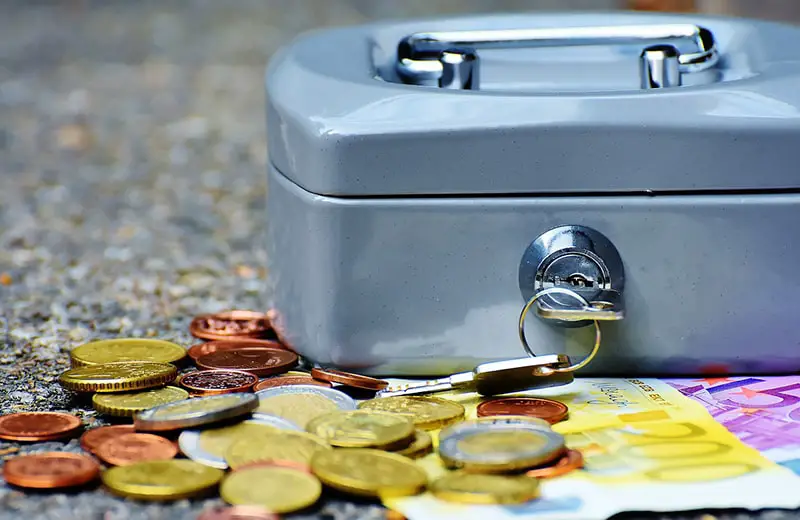Click here to get this post in PDF

If you’ve worked for a company that had a brick and mortar location or office, most likely they kept a small amount of cash on hand. A petty cash fund lets you easily and quickly pay for those small expenses that aren’t worth cutting a check for, or when an employee doesn’t want the hassle of filing an expense report. Maybe you just used the last bit of coffee, and everyone is getting grumpy and cranky. Or someone in the office has a birthday, and you want to get them a card and flowers. Or everyone is working late, and you need to pay the pizza guy.
For expenses like those, a petty cash fund is an ideal solution.
What Can You Use Petty Cash For?
Petty cash can be used for small, occasional expenses. It should not be used to pay regular operating expenses like rent or payroll. It should also not be used to give employees an advance on their paycheck. But here are a few of the things petty cash is often used for:
- Lunch for the office
- Stamps
- Flowers
- Birthday or thank you cards
- Gas for company cars
- Parking
- Coffee
- Water
- Office supplies
Individually, these expenses are small, but they can add up over time. With a petty cash management system in place, an organization can keep track of these.
Why Use Petty Cash?
Reimbursing employees for small purchases made on behalf of the business can be faster and easier with petty cash. Requesting a check from the bookkeeper might take a few days. Filing an expense report generally means that the employee will have to wait for the next pay cycle for reimbursement. Using petty cash can also be less risky than simply handing an employee the company credit card when they have to run a quick errand.
Choose a custodian. This should be someone who is generally available during business hours, and who sits near the front of the business. The custodian should be someone known to be trustworthy and honest. Avoid choosing someone with known financial pressures because that can easily lead to fraud.
Establish a petty cash policy. This policy should include the following elements:
- Total amount of the petty cash fund, or the float
- Maximum amount of a transaction
- Allowed and disallowed uses
- Procedures for disbursement, replenishment and safeguarding
Put these policies in writing and share them with all employees.
Fund petty cash. The float in petty cash should be high enough that the fund won’t need to be replenished more than once a week or month. Typically, this is somewhere between $50 and $500, but larger organizations may have petty cash funds of up to $10,000.
Lock the funds up. Use a secure locking box or drawer. Keep this locked up and out of easy access by customers and employees. The custodian and another responsible person, such as the business owner, controller, or CFO, should be the only ones with access.
Reimburse expenses. The employee gives the custodian proof of their purchase, and the custodian gives the employee cash. In some organizations, employees may take an advance from petty cash and leave behind a signed voucher or IOU, then return with the receipt and change.
Keep a log of transactions. The custodian should keep a written log that includes the date, name of the employee, amount spent, where the money was spent, and the purpose for every petty cash transaction. This can be on paper, or in a spreadsheet.
Reconcile petty cash. At least monthly, the petty cash fund should be reconciled against the recorded expenditures. Weekly reconciliations may be needed if there’s a high volume of transactions. A best practice is to perform random audits at irregular intervals to keep everyone honest.
What to Watch Out For With Petty Cash
Because there is little oversight, petty cash is susceptible to fraud or theft, simply because it’s cash. Reconciliations often show small variances between the amount of cash that should be in the lockbox and what’s actually there. Most of these are small and inadvertent, and not worth pursuing further. Maybe someone forgot to bring back change, or maybe a receipt is missing. Sometimes the custodian just makes small mistakes in recording a transaction or giving out change.
But if your custodian feels any kind of financial pressure, or feels entitled to an extra bonus now and then, you may need to pay attention to these small variances. Over time, they can blow up.
Make sure the person reconciling petty cash knows how to do this task. I once saw a petty cash reconciliation that combined the amount of petty cash on hand with the balance of cash in the bank account. Perhaps it’s not too surprising that the custodian, who was also the office manager and bookkeeper, was later caught embezzling from the company.
When reconciling, make sure that the receipts are genuine. Some fraudsters have been caught when someone notices that they’ve submitted a photocopy of the same receipt multiple times.
You also want to verify that the expenses are appropriate. A reimbursement for taking a client out for a meal or coffee is appropriate. But reimbursement for an employee’s lunch when there’s no discernable business purpose is not appropriate. Expenses that are clearly and obviously personal are also a big no-no.
Petty Cash May Be on the Way Out
Because it is so susceptible to theft, some companies are opting instead for prepaid debit cards, or reimbursing employees through apps like Expensify. Stores that don’t accept cash appear to be on the upswing. But, until that day, petty cash is still a useful way to pay for all those incidental expenses that businesses have.
You may also like: 7 Tips to Make Keeping Track of Business Expenses a Breeze
Image source: Pixabay.com
